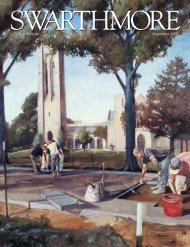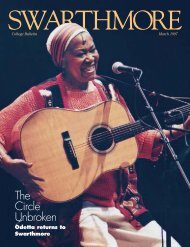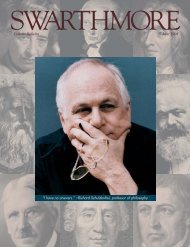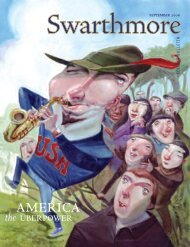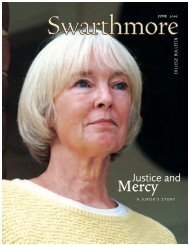A Walk in the Woods
Swarthmore College Bulletin (March 2001) - ITS
Swarthmore College Bulletin (March 2001) - ITS
Create successful ePaper yourself
Turn your PDF publications into a flip-book with our unique Google optimized e-Paper software.
chosen not to receive advanced degrees butare far<strong>in</strong>g well <strong>in</strong> <strong>the</strong> world.ESTEBAN CARDEMIL ’93Providence, R.I.“NEGATIVE PATHOLOGIES”I write not to support <strong>the</strong> decision to dropfootball (as <strong>the</strong> College asserted on its Website) but to po<strong>in</strong>t out that <strong>the</strong> issue is farmore complex than ei<strong>the</strong>r side’s public commentsadmit.Look<strong>in</strong>g at Swarthmore’s won-lost recordss<strong>in</strong>ce <strong>the</strong> 1960s—when <strong>the</strong> NationalCollegiate Athletic Association allowed twoplatoonfootball, mak<strong>in</strong>g it impossible tocompete with a team of 30 players—it isclear that most Swarthmore football teamsendured los<strong>in</strong>g records and <strong>the</strong> pa<strong>in</strong> thatgoes with <strong>the</strong>m. Even those who experiencedw<strong>in</strong>n<strong>in</strong>g seasons felt marg<strong>in</strong>alized asma<strong>in</strong>stream male athletes on Swarthmore’scampus. One of my ex-players commentedon <strong>the</strong> Board’s decision, “at least kids won’thave to suffer what we did”—and this youngman played on teams with w<strong>in</strong>n<strong>in</strong>g records3 of his 4 years at Swarthmore! Many negativepathologies develop on los<strong>in</strong>g teamsand <strong>in</strong> environments where people feel likeoutcasts.All members of <strong>the</strong> Board should also behonest concern<strong>in</strong>g <strong>the</strong>ir role <strong>in</strong> <strong>the</strong> deteriorationof traditional team sports at <strong>the</strong> College.Several teams (<strong>in</strong>clud<strong>in</strong>g football, witha 7–3 record <strong>in</strong> 1990 and a 5–3–1 secondplaceConference f<strong>in</strong>ish <strong>in</strong> 1992; and basketball,with an Eastern Collegiate AthleticConference playoff team <strong>in</strong> 1991) enjoyedsuccess <strong>in</strong> <strong>the</strong> last years of Bob Barr’s [’56]tenure as dean of admissions.When <strong>the</strong> Board hired Al Bloom andapproved his policies to <strong>in</strong>crease diversitywhile also <strong>in</strong>creas<strong>in</strong>g <strong>the</strong> academic rigor of<strong>the</strong> enter<strong>in</strong>g class, it set <strong>in</strong> motion <strong>the</strong>demise of football. By <strong>the</strong> mid-1990s,almost all team sports were laughably bad,and <strong>the</strong> traditional male team sports wereanemic. It was at that po<strong>in</strong>t that <strong>the</strong> Board“discovered” <strong>the</strong> crisis and attempted <strong>the</strong>heroic rescue of football that has beenended by last December’s decision.S<strong>in</strong>ce 1992, <strong>the</strong> Bloom adm<strong>in</strong>istrationmade clear that its mission was to makeSwarthmore more uniquely Swarthmorean.Although <strong>the</strong>re was no overt desire to harmathletics, it was a case of malevolent neglect.At a school where <strong>the</strong> successful teams operatedon such a small marg<strong>in</strong>, <strong>the</strong> new admissionsemphases (without any correspond<strong>in</strong>grole for athletics) spelled doom. The Boardof Managers and its tradition of consensus(or, more precisely, its <strong>in</strong>ability to reach aconsensus on ei<strong>the</strong>r elim<strong>in</strong>at<strong>in</strong>g football orsupport<strong>in</strong>g it properly) produced a negativesituation where players failed to enjoy <strong>the</strong>positive aspects of <strong>the</strong> sport and wherecoaches had <strong>the</strong>ir careers short-circuited—or else retired embittered. Perhaps a fewpowerful alumni “preserved” football but atwhat human cost?Although <strong>the</strong> Board’s action was traumaticfor <strong>the</strong> current coaches and players,what has been done to <strong>the</strong>m follows <strong>the</strong> historyof Swarthmore College. Many playersand coaches who loved <strong>the</strong> school and <strong>the</strong>irsport have had <strong>the</strong>ir hearts broken by failurepredest<strong>in</strong>ed by <strong>the</strong> College’s admissionspolicies. Like me <strong>in</strong> 1990, <strong>the</strong>y were foolishenough to believe that <strong>the</strong>y had a chance todo what had never been done s<strong>in</strong>ce <strong>the</strong>1960s—to make football a long-stand<strong>in</strong>g,successful program. Should we all haveknown better? Probably so, but hope canbl<strong>in</strong>d even <strong>the</strong> smartest people.KARL MIRANSwarthmore, Pa.Miran was head football coach from 1990 until1998.CHANGING THE COLLEGE’S CULTUREI write as a former member of <strong>the</strong> Board ofManagers and a fellow educator to expressmy deepest concern about <strong>the</strong> abolition offootball at Swarthmore. I believe this decisionwould, first, be disastrous for Swarthmore;second, alter <strong>the</strong> ethos of <strong>the</strong> campus;and, third, be socially irresponsible.Swarthmore’s deserved reputationamong undergraduate liberal arts collegesstems from its decades-long, successful pursuitof two <strong>in</strong>terrelated goals: academicexcellence and diversity among its studentbody. Abandonment or significant narrow<strong>in</strong>gof its current <strong>in</strong>tercollegiate athleticsprogram (of which football is <strong>the</strong> flagshipprogram because of <strong>the</strong> unique historicaland cultural role it has played <strong>in</strong> <strong>the</strong> historyof American higher education) would signalthat <strong>the</strong> college has decided to abandon itsprevious commitment to recruit a diversestudent body.Abandonment of football would signalthat <strong>in</strong>stead of consider<strong>in</strong>g Williams, Wesleyan,Amherst, Oberl<strong>in</strong>, Lawrence, Pomona, orCarleton as our peer <strong>in</strong>stitutions, Swarthmorewould be configur<strong>in</strong>g itself to competewith Benn<strong>in</strong>gton, Antioch, Haverford, SarahLawrence, Vassar, or Brandeis.The absence of football would tell applicantswho wish to be part of a well-roundedstudent body: You’ll be happier elsewherebecause at Swarthmore your class will notconta<strong>in</strong> a total range of classmates withwhom you can <strong>in</strong>teract; this college excludesand does not esteem <strong>the</strong> physically robustwho enjoy teamwork and vigorous athleticcompetition.Retention of a diverse student body is asocial responsibility of <strong>the</strong> College. Swarthmoreis unique <strong>in</strong> <strong>the</strong> education it provides—especially<strong>the</strong> social ethic it transmits.Perhaps unique among American colleges,its Quaker tradition encourages itsstudents to select socially mean<strong>in</strong>gfulcareers and to assist <strong>the</strong> less fortunate <strong>in</strong>our society. And I th<strong>in</strong>k our nation would be<strong>the</strong> poorer if, 20 years and more from now,Swarthmore’s <strong>in</strong>fluence would no longer beas strongly felt among our nation’s leaders<strong>in</strong> commerce, politics, law, and even academics.Such people are frequently scholar-athletes.Instead of an <strong>in</strong>stitution with a futureorientedmission, Swarthmore will havetransformed itself <strong>in</strong>to a college that existssolely to serve a special k<strong>in</strong>d of contemporaryclientele. It will have become a preciouslittle community of <strong>the</strong> like-m<strong>in</strong>ded that haslittle sense of its responsibility to educateand <strong>in</strong>fluence <strong>the</strong> nation’s future leaders.MICHEL OKSENBERG ’60A<strong>the</strong>rton, Calif.This letter was written <strong>in</strong> <strong>the</strong> days before <strong>the</strong>Board of Managers’ decision on athletics. Sadly,Michel Oksenberg died on Feb. 22.TCORRECTIONSThanks to Nell Lancaster ’74 for po<strong>in</strong>t<strong>in</strong>gout that <strong>the</strong> quotation attributed to NelsonMandela on <strong>the</strong> January 2001 page of <strong>the</strong>Swarthmore calendar is actually from apoem by Mary Ann Williamson. Mandelaused it <strong>in</strong> his <strong>in</strong>augural address, and it isfrequently misattributed to him.Also, <strong>the</strong> photos of Lea Haravon Coll<strong>in</strong>s’89 (December “In My Life”) were taken byJane Mart<strong>in</strong>, not L<strong>in</strong>da Kahlbaugh.M A R C H 2 0 0 179



